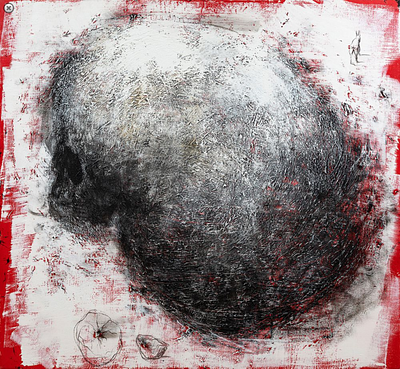ANTONI TÀPIES PUIG (Barcelona, 1923 - 2012). Untitled, ca. 1979. Mixed media on paper. Signed in the lower right corner. Attached certificate from
Lot 82
About Seller
Setdart Auction House
Carrer Aragó 346
Barcelona
Spain
Setdart Subastas was born in 2004 and is currently the first online art auction in Spain with solidity, prestige and reliability guaranteed by our more than 60,000 users. Setdart has a young, dynamic and enterprising team ready to successfully manage the purchase and sale of art works through custom...Read more
Categories
Estimate:
EUR€17,000 - EUR€19,000
$18,085.11 - $20,212.77
Absentee vs Live bid
Two ways to bid:
- Leave a max absentee bid and the platform will bid on your behalf up to your maximum bid during the live auction.
- Bid live during the auction and your bids will be submitted real-time to the auctioneer.
Bid Increments
| Price | Bid Increment |
|---|---|
| EUR€0 | EUR€10 |
| EUR€200 | EUR€25 |
| EUR€500 | EUR€50 |
| EUR€1,000 | EUR€100 |
| EUR€3,000 | EUR€200 |
| EUR€5,000 | EUR€500 |
| EUR€10,000 | EUR€1,000 |
| EUR€20,000 | EUR€2,000 |
| EUR€50,000 | EUR€5,000 |
About Auction
By Setdart Auction House
Oct 19, 2021
Set Reminder
2021-10-19 08:00:00
2021-10-19 08:00:00
America/New_York
Bidsquare
Bidsquare : CONTEMPORARY ART
https://www.bidsquare.com/auctions/setdart-auction-house/contemporary-art-7701
Setdart Auction House sofia@setdart.com
Setdart Auction House sofia@setdart.com
- Lot Description
ANTONI TÀPIES PUIG (Barcelona, 1923 - 2012). Untitled, ca. 1979. Mixed media on paper. Signed in the lower right corner. Attached certificate from the Tàpies Commission. Work registered in the archive of the artist's complete oeuvre, with the photo number T-9945. Measurements: 30 x 21 cm; 52 x 42 cm (frame). Co-founder of "Dau al Set" in 1948, Tàpies began to exhibit at the Salones de Octubre in Barcelona, as well as at the Salón de los Once held in Madrid in 1949. After his first solo exhibition at the Galerías Layetanas, he travels to Paris in 1950, with a grant from the Institut Français. In 1953 he had a solo exhibition at Martha Jackson's gallery in New York. From then on, he exhibited his work, both in group and solo shows, all over the world, in leading galleries and museums such as the Guggenheim in New York and the Museum of Modern Art in Paris. Since the 1970s, anthologies have been devoted to him in Tokyo (1976), New York (1977 and 2005), Rome (1980), Amsterdam (1980), Madrid (1980), Venice (1982), Milan (1985), Vienna (1986) and Brussels (1986). Self-taught, Tàpies created his own style within the avant-garde art of the 20th century, combining tradition and innovation in an abstract style full of symbolism, giving great importance to the material substratum of the work. It is worth noting the marked spiritual sense given by the artist to his work, where the material support transcends its state to signify a profound analysis of the human condition. Tàpies' work has been highly valued internationally, being exhibited in the most prestigious museums in the world. Throughout his career he has received numerous prizes and distinctions, including the Praemium Imperiale of Japan, the National Culture Prize, the Grand Prix for Painting in France, the Wolf Foundation for the Arts (1981), the Gold Medal of the Generalitat de Catalunya (1983), the Prince of Asturias Prize for the Arts (1990), the Picasso Medal of Unesco (1993) and the Velázquez Prize for the Plastic Arts (2003). A great defender of Catalan culture, of which he is deeply imbued, Tàpies is a great admirer of the mystical writer Ramón Llull, as well as the Catalan Romanesque and Gaudí's architecture. At the same time, he appreciates Eastern art and philosophy, which, like his own work, blur the boundary between matter and spirit, between man and nature. Influenced by Buddhism, his paintings show how pain, both physical and spiritual, is inherent to life. Antoni Tàpies is represented in major museums all over the world, such as the foundation that bears his name in Barcelona, the Reina Sofía in Madrid, the Guggenheim in Berlin, Bilbao and New York, the Fukoka Art Museum in Japan, the MoMA in New York and the Tate Gallery in London.
- Shipping Info
-
In-house shipping available. Please inquire at admin@setdart.com.
-
- Buyer's Premium



 EUR
EUR CAD
CAD AUD
AUD GBP
GBP MXN
MXN HKD
HKD CNY
CNY MYR
MYR SEK
SEK SGD
SGD CHF
CHF THB
THB














